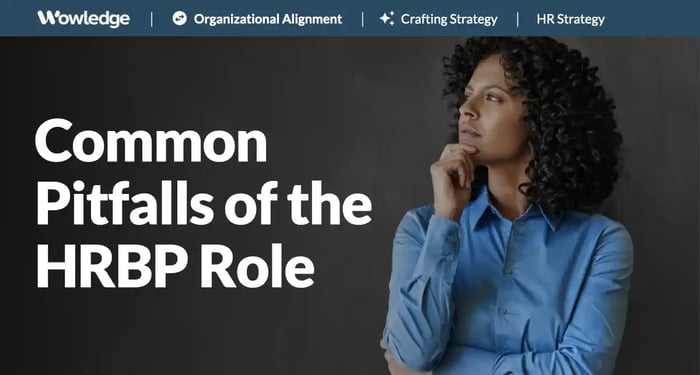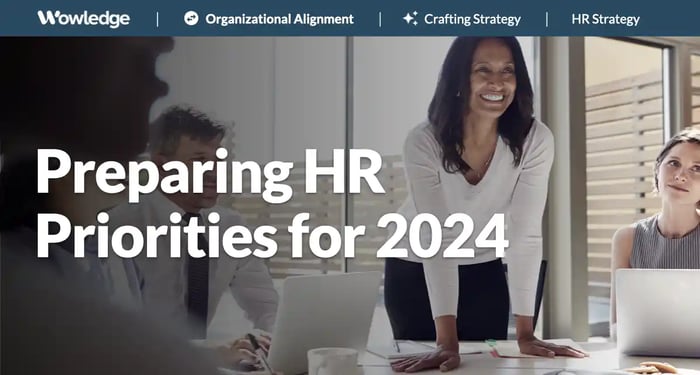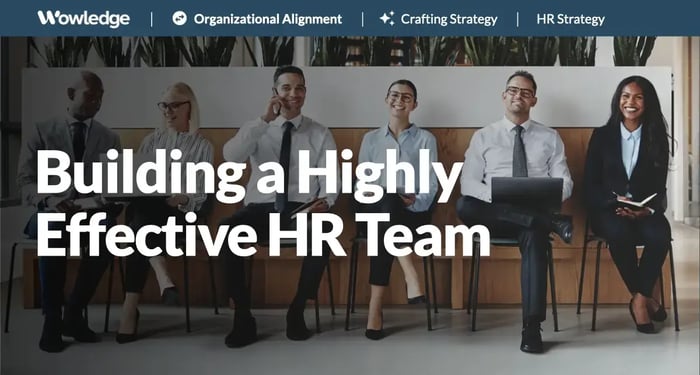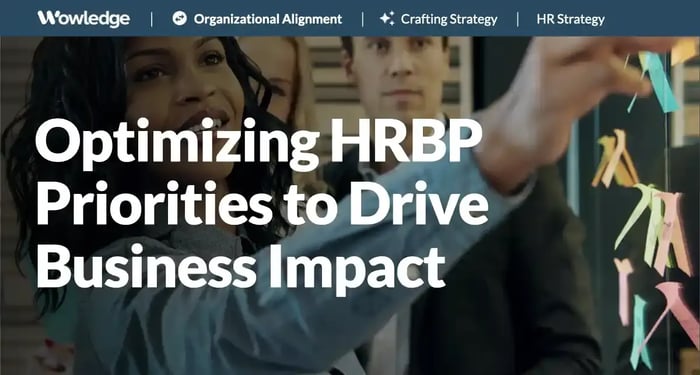Table of Contents
We at Wowledge have garnered a lot of interest in our posts and position papers on improving HR, building a more impactful HR team, the role of the CHRO, and in particular, the HR Business Partner (HRBP) priorities. In each of these, we discuss a primary objective of HR as strategically influencing and supporting the business and its key objectives. How that is accomplished is the question, with many avenues and methods. As the HRBP is a key role designed to identify business challenges and objectives that can be positively influenced through talent programs, processes, and activities, considering how to optimize that role is essential. What is most interesting, however, is the wide variation in duties and responsibilities that different writers and experts attribute to the HRBP role, no doubt contributing to a certain level of confusion and disagreement. What all those experts agree on, however, is the unique positioning of the role as a strategic partner to business leaders. And achieving that requires understanding the common pitfalls of the HRBP role.
Many experts also point to the most common pitfalls of the HRBP role and the extent to which position holders struggle to spend most of their time in truly strategic tasks and work efforts. Ask any HRBP today, and the likelihood that they will complain about getting pulled into tactical or administrative work is extremely high, if not universal (an outcome of several of the common pitfalls of the HRBP role). Given the struggle that HR teams continue to be accepted as business partners, it should come as no surprise that they continue to be perceived as owners of “everything HR,” including small issues such as benefits enrollment challenges, employee relations issues, etc. The classic issue for HR is balancing support and delivery of more administrative or enterprise-wide processes and activities (annual merit pay, benefits enrollment, employee relations) with tailored, strategically-focused solutions (organizational design, team building, high potential (HiPo) assessment and development).
Some excellent insights have been generated by McKinsey, pointing to the need to change the name and laser-focus the efforts of the role. We agree while accepting the realities that face HR functions as they try to design and manage the role to maximize its strategic contributions. The core aspect of this is the design and execution of the role – and understanding the common pitfalls of the HRBP, and how to free those critical strategic resources best to perform the strategic work they are being asked to do.
The HRBP role
Starting with an understanding of the role of the HRBP and how it differs from that of other HR roles, it becomes clear how those occupying the HRBP should spend their time. The role is designed to be a primary resource on people and talent strategies for an assigned part of the organization. As well as one can manage it, the HRBP acts as a communicator and distributor of business requirements to various HR Centers of Excellence (COE) and functions, thus enabling their requirements and issues to be blended with those of other parts of the organization to establish function-specific programming that addresses the needs of the broader organization. The specialized issues that require highly tailored and integrated responses are generally handled by the HRBP, which leads the effort, using resources from the COEs as needed to assess a situation, develop a response and action plan, and execute it to resolve the talent or business challenges.
Key contributions from HR Business Partners include:
Strategic Planning and Alignment
The HRBP is critical in ensuring that HR strategies and initiatives align seamlessly with business goals. This involves understanding the nuances of the business and its strategic direction and crafting HR interventions that support and drive these objectives. It uses that understanding of business objectives and plans to develop advanced planning for projecting and developing workforce size and capabilities. Another critical goal is to cultivate a leadership team and workforce equipped and motivated to fulfill the company's mission and vision over time and across changing operational circumstances.
Talent Management and Development
HRBPs are instrumental in identifying talent gaps within their designated business units and orchestrating plans to bridge them. This includes collaborating with HR COE partners on succession planning, facilitating leadership development efforts, identifying opportunities and interventions to improve productivity and unit performance, and ensuring employee segments have growth opportunities that align with business needs.
Change Management
As businesses evolve, change is inevitable. HRBPs are often at the forefront of driving organizational change, ensuring that transitions, whether they involve mergers, acquisitions, or shifts in business strategy, are smooth and that employees are engaged and supported throughout the process. Helping the organization and its people prepare for and adapt to changing business circumstances and objectives, including building an agile and resilient business culture, is essential to the role.
Stakeholder Collaboration
A significant part of the HRBP's role is to build robust relationships with key stakeholders within their business units. They maintain a key HR coaching and consulting relationship with the business. By acting as advisors, they recommend best practices, gather feedback, and ensure that HR's contributions are relevant and impactful to the business segment they support. As coaches, they provide feedback and guidance to leaders and managers as they work to direct their teams toward optimized performance and productivity.

The issue with the HRBP role versus the expectations of the HR function
So far, so good, right? The HRBP is ideally positioned as a strategic partner with business leaders. However, that partnership is conducted in the context of the purpose and primary contributions expected from the entire HR function. And, as the HRBP is considered the primary liaison to a part of the organization (location, division, function), it is easy to see how they can be asked to help solve non-strategic issues, representing common pitfalls of the HRBP role and responsibilities. A quick review of the key HR functions reveals some challenges to the HR Business Partner executing its role as designed.
- Talent Acquisition and Recruitment
- Learning and Development
- Performance Management
- Compensation and Benefits
- Employee and Labor Relations
- Workforce Planning and Strategy
- Career Management
- Compliance with Labor Laws
- Diversity and Inclusion
- HR Information Systems (HRIS) Management
- Employee Engagement and Culture
- Health and Safety
Reviewing this list, note the dominance of repeatable, high-volume processes impacting the entire workforce that include tasks of a highly administrative nature (recruiting, learning and development, performance management, compensation, and benefits) or those with heavy policy/compliance-based and data reporting tasks (employee relations, health and safety, diversity and inclusion, compliance with labor laws, HRIS). While some of these certainly require skilled and tailored responses at times to help deal with specific business or talent challenges, they are generally made up of work that requires annual updating of their design and implementation. What is left then are Workforce Planning and Strategy, Employee Engagement, and Culture, which require continuous attention and management at the local, business unit, and enterprise levels. It is those functions upon which an HRBP tends to focus their attention. Working on those strategic and complex issues can be a challenge when faced with the common pitfalls of the HRBP role.
The implications? Most HR activities touch all employees and are front and center in leaders' and managers’ minds. The challenge is that managers expect HR support on all of these and want answers and solutions to issues that arise from those. Given the assignment of an HRBP to a business unit (and the desire and/or requirements to be viewed as a responsive problem solver), all HR issues that come to the HRBP can become priorities. As a result, the primary reason for the HRBP’s existence as a strategic, business-focused, and forward-viewing partner can become muddled in the day-to-day noise of employee and managerial concerns.

The factors (and solutions) that drive HRBPs into the trap of doing non-strategic work
Being pulled into doing non-strategic work is mostly due to a number of factors that represent the common pitfalls of the HRBP role. These roles are designed to be strategic liaisons between HR and the business, focusing on high-level planning and aligning HR services with business objectives. However, various challenges can sidetrack HR Business Partners from this strategic focus:
1. Operational demands
Often, HRBPs are pulled into day-to-day operational tasks, such as addressing individual employee issues, managing administrative tasks, or filling in for the operational gaps within the HR department. These demands can consume significant time and energy, diverting attention from strategic initiatives.
Solution: Assign clear lines of authority (and escalation) for the core HR functions and processes. Conduct an audit of each key process, using methodologies and tools such as RACI (a responsibility assignment matrix) charts to clearly define who is responsible and can be called upon when issues arise. Publish those names/roles and contact information so the manager or HRBP can point the manager or employee to the person who can handle the issue. Develop responsiveness and closure metrics to track success rates and assign those as performance criteria for those job holders.
2. Lack of clear role definition
In some organizations, the role of an HR business partner is not clearly defined or understood. This ambiguity can lead to a mismatch in expectations from other departments and within HR itself, with strategic roles being diluted with operational tasks that should ideally be handled by other HR functions. Also, the HRBP is viewed as an escalation point given their assignment as the HR liaison to a particular part of the business.
Solution: Document and assign responsibilities for every HR process, practice, program, and system. Include and widely communicate escalation points for every function and broad exercise so that issues with regularly occurring employee lifecycle processes (e.g., annual enrollment, performance evaluations, employee complaints/charges, etc.) have clear escalation points for each level, from employees to VP’s.
3. Insufficient resources
Limited resources, including staffing, technology, and budget constraints, can force HR business partners to take on non-strategic tasks simply because there's no one else to handle these responsibilities. This is especially true in smaller organizations or in times of cost-cutting.
Solution: Limit the number of HRBP’s, with more HR staffers assigned to specialists (in COEs or HR Shared Services) and generalist roles (HR Managers). Staff generalist or specialist roles (either in the business units or part of HR Shared Services teams) and assign them responsibility for handling employee and manager inquiries, employee relations cases, managing annual processes (performance evaluations, benefits enrollment), etc.
4. Skillset misalignment
HR business partners may find themselves doing non-strategic work if there is a mismatch between their skill set and the strategic demands of their role. They may default to more familiar operational tasks without adequate training or experience in strategic HR practices.
Solution: Carefully assess, identify, and grow HRBP’s. Create a career ladder in HR that develops current and future HRBPs’ skills in organization development (OD), performance consulting, Six Sigma/Lean, financial management, business operational expertise, HR analytics, reporting/storytelling, etc. Consider hiring those with operational expertise outside of HR by using assessment strategies to identify potential HRBPs from the business – e.g., engineering, technology, sales, marketing, etc. for those with overlapping skills and interpersonal capabilities to perform the job.
5. Lack of support from leadership
HR business partners may struggle to assert their strategic role without strong support from senior leadership. Leadership's failure to recognize the strategic value of HR can result in HR business partners being overloaded with operational duties.
Solution: Communicate the role and expectations of the HRBP with all leaders, and intervene when necessary to support the individual's tasking and work efforts. Engage the top leadership team in supporting and championing the role with frequent check-ins and discussions regarding each HRBP's efforts on the business unit's behalf.
6. Lack of HR strategic planning
A lack of strategic planning and focus within the HR function itself can lead to HR business partners being caught up in non-strategic work. Without a clear strategic plan that outlines the role and focus of HR business partners, they may default to addressing immediate operational needs. This is compounded if the HR department is seen primarily as an administrative or support function rather than a strategic partner.
Solution: Establish formal HR strategies at enterprise and business unit/function/location levels with strong linkages between HR plans and business objectives/challenges. Engage leaders at each level to review and/or co-develop the HR plans to support their business. Ensure that appropriate performance metrics align the HR efforts with business and associated talent issues that the HRBP will address.
7. Cultural factors
Organizational culture plays a significant role. In cultures that do not value HR as a strategic partner, HR business partners are more likely to be pulled into non-strategic work. Overcoming this requires changing the perception of HR's role within the organization, which is a significant challenge.
Solution: In addition to limiting the number of HRBPs to ensure enough resources are allocated to other HR functions, strategic planning, frequent reporting on business and related talent issues and market trends, and how HR will address those go a long way toward building credibility. Creating and publishing HR metrics and data attuned to managers’ and leaders’ questions creates a similar effect.
8. Lack of business breadth and depth
HR professionals traditionally and most commonly come from non-business or technical educational and experiential backgrounds. Social sciences, liberal arts, and related degree programs continue to dominate the backgrounds of HR team members. This results from the job requirements emphasizing interpersonal skills, communications, process/procedure design and management, adult learning, legal compliance, etc. A continuing lack of data and statistical expertise in HR is a direct pointer to the insufficient development of quantitative skills normally found in those with business, scientific, and technology career fields.
Solution: Traditional HR professionals are not known as business experts, and as such, that perception impacts the credibility of their entire function. It is critical that HRBPs develop and continuously maintain their knowledge and expertise in how the business is run, its primary and competitively differentiating capabilities, and how the company generates revenue and profit. They can develop expertise in the elements used in a modern and impactful HR strategic plan, including external factors such as macroeconomic and industry trends, internal barriers such as automation or production facility shortcomings, sales struggles in the region “A,” etc.
9. Not being able to say “No”
The most trusted and credible partners are those asked to solve intractable problems across the spectrum of HR services. The issue is that they deliver consistently and at a high level and, as a result, are often asked to resolve seemingly petty issues. This may appear overly basic, but it occurs with great regularity.
Solution: Clarify role responsibilities and use the coaching and performance management processes to keep HRBPs from performing these tasks “as a favor” to their assigned clients. While this can appear to be easy, supporting the HRBPs who do so and receiving resistance is key to developing a stronger “backbone.”
Overcoming these challenges requires clear role definition, adequate resources, ongoing development of strategic HR skills, strong leadership support, effective HR structure, and a culture that values HR's strategic contribution. It calls out the need to assess and address the common pitfalls of the HRBP role and the extent to which it is compromising or limiting the effectiveness of those professionals.
Relevant Practices & Tools
Core HR Strategy Practices to Define a Foundational Direction for the HR Function. >
An HR Strategy defines the process of identifying business-based human resource (HR) tactics that will constitute a comprehensive multi-year approach to managing the HR function... more »
HR Business Partner Success Profile: Deep Dive. >
An HR Business Partner (HRBP) is a strategic role within the Human Resources function, closely collaborating with business leaders to align HR strategies with business objectives... more »
HR Manager, HR Generalist, and HR Business Partner Role Differences: Deep Dive. >
While on the surface, the roles of HR Managers, HR Generalists, and HR Business Partners (HRBPs) might appear to overlap, each position possesses a unique set of skills and expertise... more »
Establishing a Core Talent Management Strategy to Set Priorities and a Strategic Roadmap. >
As a company defines its business strategy, each function must align its objectives and actions to support its strategic goals. Talent management strategy is a key process that the HR function... more »
The External Environmental Scan Tool: Capture and Categorize Factors Outside of the Company’s Scope Impacting its Objectives. >
This template provides a structure for identifying key external topics that should be considered in a formal analysis of the business’s upcoming challenges... more »
About Wowledge
Wowledge is the expert-driven platform for lean teams building strategic HR programs. Members enjoy access to up-to-date best practices, step-by-step guides, tools, templates, and insights to accelerate the design and implementation of all key HR programs and processes.
Since each organization has unique characteristics, needs, and aspirations, Wowledge's practices are developed utilizing an exclusive stage-based approach – from Core to Advanced to Emerging – that reflects distinct levels of sophistication to meet our members where they are.
Build strategic HR programs with refreshingly easy-to-follow best practices.
Get started for FREE! Learn more.










